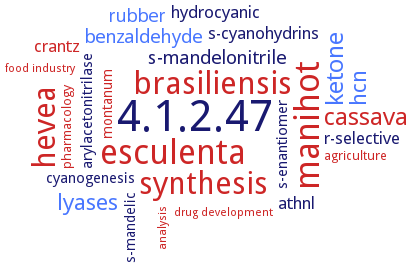4.1.2.47: (S)-hydroxynitrile lyase
This is an abbreviated version!
For detailed information about (S)-hydroxynitrile lyase, go to the full flat file.

Word Map on EC 4.1.2.47 
-
4.1.2.47
-
esculenta
-
manihot
-
brasiliensis
-
hevea
-
synthesis
-
cassava
-
ketone
-
hcn
-
lyases
-
benzaldehyde
-
s-mandelonitrile
-
rubber
-
athnl
-
crantz
-
hydrocyanic
-
s-cyanohydrins
-
r-selective
-
arylacetonitrilase
-
s-enantiomer
-
cyanogenesis
-
montanum
-
s-mandelic
-
pharmacology
-
agriculture
-
analysis
-
drug development
-
food industry
- 4.1.2.47
- esculenta
- manihot
- brasiliensis
- hevea
- synthesis
- cassava
- ketone
- hcn
- lyases
- benzaldehyde
-
s-mandelonitrile
- rubber
- athnl
- crantz
-
hydrocyanic
-
s-cyanohydrins
-
r-selective
- arylacetonitrilase
-
s-enantiomer
-
cyanogenesis
- montanum
-
s-mandelic
- pharmacology
- agriculture
- analysis
- drug development
- food industry
Reaction
Synonyms
(R)-LuHNL, (R)-Oxynitrilase, (S)-cyanohydrin producing hydroxynitrile lyase, (S)-Hb-HNL, (S)-HbHNL, (S)-HNL, (S)-Hydroxynitrile lyase, (S)-Me-HNL, (S)-MeHNL, (S)-Oxynitrilase, (S)-selective HNL, (S)-selective hydroxynitrile lyase, Acetone cyanohydrin lyase, ACL, alpha-Hydroxynitrile lyase, EC 4.1.2.37, EC 4.1.2.39, Hb-HNL, HbHNL, HNL, HNL1, Hydroxynitrile lyase, LuHNL, MeHNKL, MeHNL, mut-HNL1, Oxynitrilase, S-HnL, S-hydroxynitrile lyase, S-selective HnL, S-selective hydroxynitrile lyase, S-stereoselective HNL
ECTree
Advanced search results
Cloned
Cloned on EC 4.1.2.47 - (S)-hydroxynitrile lyase
Please wait a moment until all data is loaded. This message will disappear when all data is loaded.
cloned and produced by heterologous expression in different microbial hosts
-
expressed in Escherichia coli BL21(DE3) cells
expressed in Pichia pastoris, Leishmania tarentolae, Escherichia coli strain JM109 and in two cell-free translations, including an Escherichia coli lysate (WakoPURE system) and wheat germ translation system
-
expression in Escherichia coli
expression in Escherichia coli BL21 (DE3)
expression of mutant and wild-type proteins in Saccharomyces cerevisiae
expression of wild-type and mutant enzymes in Escherichia coli BL21
full-length cDNA functinal expressed in Escherichia coli, Pichia pastoris and Saccharomyces cerevisiae
-
high expression in a multi-auxotrophic mutant of Saccharomyces cerevisiae
limitations in enzyme supply from natural resources are overcome by production of the enzyme in the microbial host systems Escherichia coli, Sachycharomyces cerevisiae, and Pichia pastoris. Expression of Hnl in the prokaryotic system leads to the formation of inclusion bodies whereas in both yeast hosts high levels of soluble protein are obtained. Highest yields are obtained in a high cell density batch fermentation of a Pichia pastoris transformant that expresses heterologous Hnl to about 50% of the soluble cytosolic protein. At a cell density of 100 g/liter cell dry weight, a volume yield of 22 g/liter of heterologous product is obtained. Attempts to produce the Hnl protein extracellularly with the yeast hosts by applying different leader peptide strategies are not successful. Immunofluorescence microscopy studies indicate that the secretion-directed heterologous Hnl protein accumulates in the plasma membrane forming aggregated clusters of inactive protein
overexpression of the enzyme in transgenic Manihot esculenta plants under the control of a double 35S CaMV promoter. Enzyme activity increases more than 2fold in leaves 13fold in roots of transgenic plants relative to wild-type plants. Elevated levels of hydroxynitrile lyase levels are correlated with substantially reduced acetone cyanohydrin levels and increased cyanide volatilization in processed or homogenized roots. Unlike acyanogenic cassava, transgenic plants overexpressing the enzyme in root retain herbivore deterrence of cyanogens while providing a safer food product (cyanide toxicity)
-
recombinant Pichia pastoris strains are constructed which simultaneously expressed the (S)-oxynitrilase of Manihot esculenta and the arylacetonitrilase of Pseudomonas fluorescens EBC191 each under the control of individual AOX1 promoters in order to obtain a whole cell catalyst for the synthesis of (S)-mandelic acid from benzaldehyde and cyanide production of optically active cyanohydrin compounds
-
succesfully overexpressed in Escherichia coli, Saccharomyces cerevisiae and Pichia pastoris
-
wild type and mutant H103L are expressed in Escherichia coli strain JM109, in Pichia pastoris and Leishmania tarentolae, as well as in an Escherichia coli lysate (WakoPURE system) and wheat germ translation system
-


 results (
results ( results (
results ( top
top





